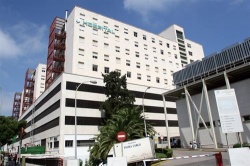Emergency healthcare in Spain
People prefer to seek medical help in public rather than private hospital

According to Spain’s Health Ministry (Health Barometer 2010), among the people surveyed 30.1% had visited an emergency service at a public or private healthcare centre in the last 12 months – slightly lower than in the preceding year (31.5%).
The average frequency of use of public healthcare services was 1.82 times and for private hospital emergency services 0.20 times – both practically identical to results in previous years. The average use of emergency services at public centres were, for women 2.01 times and men1.58 whilst, on average, women used private centres 0.23 times and men 0.16 times.
As in previous years, in 2010 most of those surveyed (46.3%) who had some sort of health problem needing immediate care, preferred the public hospital emergency service as the single and sole option, without first having requested care at a primary care emergency service. That percentage is 2.3 points higher than the year before (44%), though lower than in all the preceding years.
More than five in every 10 people go to hospital emergency services, whether because it is the only immediate option or as a complement to the care they received previously at a public or private primary care service. In this edition of the Barometer, the percentage (54.5%) using the option of going to hospital is similar to that of 2009 (53.2%). The second most widely used alternative is the public primary care emergency service, where 39.5% of those needing emergency care sought it. The series showed that people are beginning to make greater use of primary care emergency services.
Of all those who went to a public hospital’s emergency service to solve a health problem needing immediate care, eight in ten (78.8%) did so as a personal decision. This variable, which may be forming a trend towards an increase, is the highest percentage found in any edition of the Barometer. Moreover, once again it would make it clear that there is a preponderance [greater credit] held by public hospital emergency services of solving urgent problems, and the people’s trust in these clinical units. Only 20.4% of those who went to a hospital emergency room did so due to instruction by a family doctor or because they were sent from a primary care emergency service.
Almost eight in 10 people who went to a public hospital emergency service mainly did so as the result of a personal, not a clinical, decision.
There were two reasons given by those who went directly to the hospital emergency service – the hospital would be better equipped and be better able to solve problems (37.7%) or because the time when the problem occurred was outside their family doctor’s opening times (36.5% of all cases). Other reasons shy they used the hospital emergency services were given in notably lower percentages than the two reasons indicated above.
Satisfaction
Eight in 10 survey respondents given treatment at a primary care emergency service or that of a hospital (77.8%), stated it was very good or good. Men (78.1%) stated that the care in emergency services was very good or good at a rate practically equal to women (77.6%). As for the speed with which they received care in the emergency room, the percentage of people who believe it was given very quickly or fairly quickly (63.8%) is similar to the percentage in recent years. Care was provided not very quickly or not quickly at all in the opinion of 34.8%, a result very similar to that of prior years.
Emergency services used by immigrants
Interestingly, Buron et al (2008) from the Hospital del Mar, Barcelona, studied hospital emergency services use among the immigrant population in that city, comparing emergency department utilisation rates between Spanish-born and foreign-born residents in a public hospital.
The overall lower utilisation rates obtained for foreign-born residents is consistent with previous studies and probably due to the ‘healthy immigrant effect’. Thus, the population increase due to immigration does not translate directly into a corresponding increase in the number of emergency contacts. The lack of differences in minor and gynaecological emergency care supports the hypothesis that immigrants overcome certain barriers by using the emergency department to access to health services. The issue of healthcare barriers should therefore be addressed, especially among immigrants.
The prevalence of processes and pathologies dealt with by pre-hospital emergency medical services. (Pacheco et al. 2011).
Carried out by contacting 26 Medical Emergency Services (MES) and using a survey, this study received final data from 22 MES. Population covered: 42,538,730 Spaniards. Total number of calls: 7,656,768, with 711,228 interventions. Number of operational forces: intensive care units (mobile-ICUs): 329, rapid intervention vehicles (RIV) 20, health ambulances 39 and medical helicopters 39 (five of these 24-hour: Canary and Balearic Islands and Castille-La Mancha) and three airplane Interventions: mobile-ICUs: 94.3%, medical helicopters: 1.4% and health ambulances: 4.3%. Number of A&E doctors/day: 388, nursing personnel 427. Pathologies dealt with, grouped according to ICE-9-MC: V-psychiatry group: 3.7%, VI-neurological group: 2.7%, VII-cardiovascular group: 9.3%, VIII-respiratory group: 3.2%, XVII-lesions poisonings group: 23.1%, IX-digestive group: 1.3%, X-XI-genital-urinary and gynaecology-obstetrics groups: 1.4%, XVI-group of other ill-defined pathologies: 40.1%. Specifically studied groups (from the MESs that provided them) were: thoracic pain - dyspnoea: 3.7%, ictus/acute cerebrovascular accident: 0.9%, alteration in consciousness: 7.7%, syncope-blackout: 2.5%, self-inflicted lesions: 2,654 (0.4%). Total of pathological and syndrome groups: 59.9% and total of other ill-defined pathologies: 40.1%. Of the pathologies considered to be of greater relevance in A&E: acute coronary syndrome: 3.1%, arrhythmias: 3.2%, cardiac arrest: 1.7%, respiratory stoppage: 0.16%, total traumatisms: 34.9%, traumatisms: 1.16%, cranio-encephalic traumatism: 1.77%, intoxications: 5.1%, aggressions: 6.9%, burns: 0.26%.
10.01.2013






